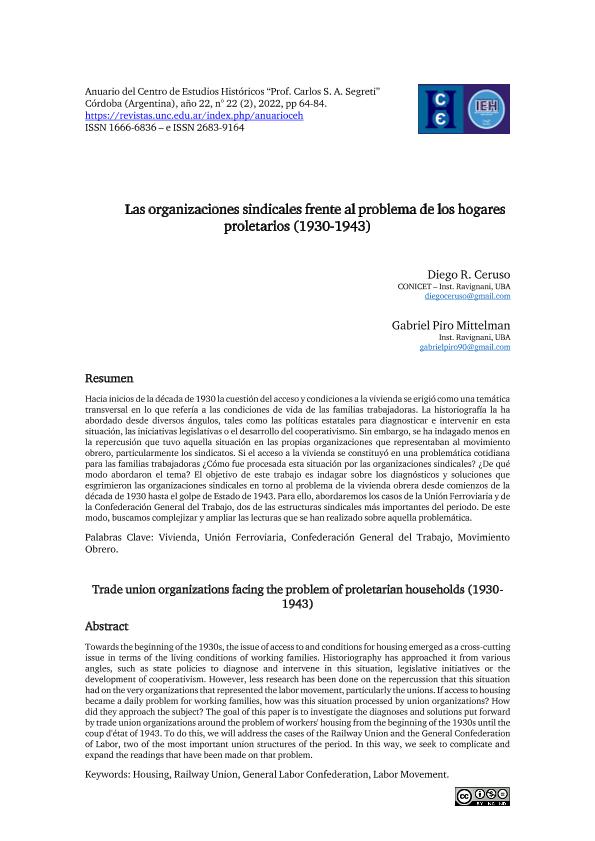Artículo
Hacia inicios de la década de 1930 la cuestión del acceso y condiciones a la vivienda se erigió como una temática transversal en lo que refería a las condiciones de vida de las familias trabajadoras. La historiografía la ha abordado desde diversos ángulos, tales como las políticas estatales para diagnosticar e intervenir en esta situación, las iniciativas legislativas o el desarrollo del cooperativismo. Sin embargo, se ha indagado menos en la repercusión que tuvo aquella situación en las propias organizaciones que representaban al movimiento obrero, particularmente los sindicatos. Si el acceso a la vivienda se constituyó en una problemática cotidiana para las familias trabajadoras ¿Cómo fue procesada esta situación por las organizaciones sindicales? ¿De qué modo abordaron el tema? El objetivo de este trabajo es indagar sobre los diagnósticos y soluciones que esgrimieron las organizaciones sindicales en torno al problema de la vivienda obrera desde comienzos de la década de 1930 hasta el golpe de Estado de 1943. Para ello, abordaremos los casos de la Unión Ferroviaria y de la Confederación General del Trabajo, dos de las estructuras sindicales más importantes del periodo. De este modo, buscamos complejizar y ampliar las lecturas que se han realizado sobre aquella problemática. Towards the beginning of the 1930s, the issue of access to and conditions for housing emerged as a cross-cutting issue in terms of the living conditions of working families. Historiography has approached it from various angles, such as state policies to diagnose and intervene in this situation, legislative initiatives or the development of cooperativism. However, less research has been done on the repercussion that this situation had on the very organizations that represented the labor movement, particularly the unions. If access to housing became a daily problem for working families, how was this situation processed by union organizations? How did they approach the subject? The goal of this paper is to investigate the diagnoses and solutions put forward by trade union organizations around the problem of workers' housing from the beginning of the 1930s until the coup d'état of 1943. To do this, we will address the cases of the Railway Union and the General Confederation of Labor, two of the most important union structures of the period. In this way, we seek to complicate and expand the readings that have been made on that problem.
Las organizaciones sindicales frente al problema de los hogares proletarios (1930-1943)
Título:
Trade union organizations facing the problem of proletarian households (1930- 1943)
Fecha de publicación:
01/2023
Editorial:
Centro de Estudios Históricos "Prof. Carlos S. A. Segreti"
Revista:
Anuario del Centro de Estudios Históricos "Prof. Carlos S. A. Segreti"
ISSN:
2683-9164
Idioma:
Español
Tipo de recurso:
Artículo publicado
Clasificación temática:
Resumen
Archivos asociados
Licencia
Identificadores
Colecciones
Articulos(INSTITUTO "DR. E.RAVIGNANI")
Articulos de INST. DE HISTORIA ARGENTINA Y AMERICANA "DR. EMILIO RAVIGNANI"
Articulos de INST. DE HISTORIA ARGENTINA Y AMERICANA "DR. EMILIO RAVIGNANI"
Citación
Ceruso, Diego Rubén; Piro Mittelman, Gabriel Omar; Las organizaciones sindicales frente al problema de los hogares proletarios (1930-1943); Centro de Estudios Históricos "Prof. Carlos S. A. Segreti"; Anuario del Centro de Estudios Históricos "Prof. Carlos S. A. Segreti"; 2; 22; 1-2023; 64-84
Compartir




